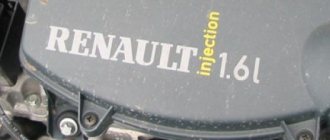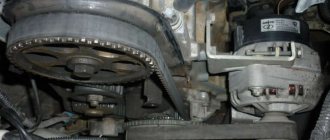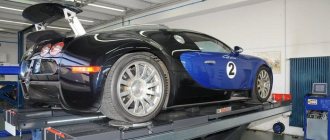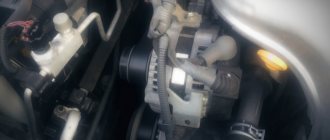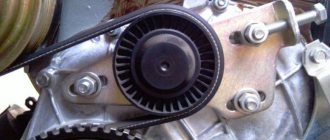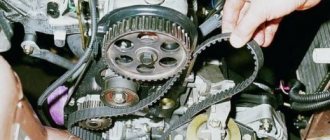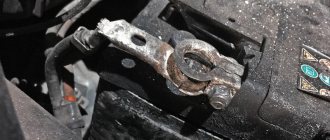Determining the causes of the malfunction
The whistling sound of the engine when starting is familiar to many car enthusiasts. So, most VAZ owners can remember this sound when starting the engine in winter and not only. This meant the water pump belt needed to be tightened or replaced. With the development of the automotive industry, everything has changed. The number of such belts in vehicles has increased.
It is worth determining why a whistle is heard when starting the engine. The main reason is the failure or stretching of one of the engine drive belts. To determine the malfunction, you need to test each belt for tension.
Maybe one of these drive elements needs to be replaced because it has exhausted its service life or turned out to be defective in manufacturing, which is not uncommon these days.
So, let's determine and consider the reasons why the engine whistles when starting. This means that one of the following elements has failed:
- Timing belt.
- Generator belt.
- Power steering belt.
- Water pump belt.
- Other attachment drive belts.
What if it's not a belt or pulleys?
Sometimes squeaking and whistling noises are not related to drive belts, rollers, attachment pulleys and tensioners. For example, extraneous noise in the engine compartment can be caused by an engine cooling fan. It is quite possible that the clutch in the fan has fallen off.
Also, squealing can (rarely) be caused by any timing drive components . Usually these are other sounds - buzzing, shuffling sounds or metallic noise. However, if this particular area is the last suspected source of extraneous sounds in the engine compartment, the problem should be corrected as soon as possible. Remember that even a faulty timing belt tensioner can contribute to engine failure.
Source
Elimination methods
A squealing belt is perhaps the only reason why a whistle may occur when starting the engine. This means that the drive element has stretched and is slipping along the pulley.
So, this significantly increases the wear of the belt itself, which will inevitably lead to tragedy in the power unit, unless, of course, the situation is corrected in time. Let's consider repair and diagnostic operations to eliminate whistling in the engine.
Timing drive
A whistling sound in the engine caused by a faulty timing belt is more than an urgent repair. If the part is not replaced in time, this will lead to a break in the drive, and at the same time to bent valves, which inevitably leads to costs.
The average, even the best belt should be changed no later than 70,000 km. Typically, car manufacturers indicate the maintenance interval for the timing belt unit in technical documentation and service books. In any case, the motorist must monitor the condition of the components and parts of the engine of his vehicle.
To determine the condition of the timing belt, it is necessary to remove the protective timing cover. Next, you should unscrew the tensioner and inspect the drive. The belt should not have cracks, burrs or other phenomena that will inevitably lead to rupture.
Also, it is worth noting that the tension of the element is very important, since a belt that is too tight is a heavy drive, which increases wear on the rubber-metal part.
With low tension, the part will slide, thereby causing a whistle. But, in modern vehicles, timing belts are used, which whistle when worn heavily.
Attachment Drive Belts
In this case the situation is still the same. Belt slippage causes a whistling sound when starting. In this case, the whistle may disappear after some time of operation. But you shouldn’t get your hopes up, because the spare part needs to be replaced as soon as possible.
Another cause of whistling, in rare cases, may be a malfunction of the water pump or drive pulleys. So, the pump has a bearing installed, which wears out over time. So, a coolant leak may form from under this element, which is quite difficult to notice, especially if it is dripping.
Thus, the production of an element can rotate it, after which the metal rubs against another metal, which leads to the formation of sound. As you know, after heating the elements expand, so the bearing, when it heated up during operation, expanded and stopped turning in the mounting location.
Deformation of the drive pulleys can also cause noise and whistling, since the belt slips in one place and cannot engage properly. The worst thing is if the resulting deformation causes the drive belt to rub against other parts.
You can diagnose and replace damaged elements yourself if you know the design features of the car, or contact a car service center or professional locksmiths for help.
It is worth noting that timely diagnosis prevents more severe damage to the power unit and its components.
How to eliminate a whistling sound when starting the engine
Elimination methods will depend on the immediate cause of the whistle when starting on a cold engine. This may be needed:
- Pull the belt.
- Clean the streams in the crankshaft or generator pulley.
- Replace a failed part, which could be a pump, roller, or bearing.
- Replace the suspension belt.
Since, according to statistics, the alternator belt is most often “to blame,” the diagnostics need to start with it. It is recommended to perform the appropriate check every 15.20 thousand kilometers or more often. Typically, a V-belt is used for a generator. When checking, you need to pay attention to the presence of cracks on its inner surface (ribs) when the belt bends. If cracks occur, the belt needs to be changed. The approximate recommended mileage of a car to replace the alternator belt is about 40...50 thousand kilometers. Please note that the life of a particular belt is also affected by its tension.
If the belt tension is loose, it must be tightened. This is usually done using a corresponding roller or adjusting bolt (depending on the design of the particular car and its engine). If a tension mechanism is not provided, then in this case it is necessary to replace the stretched belt with a new one.
To determine whether a belt or roller is whistling, since the sounds they make are very similar, you can use special protective aerosols - rubber softeners. Most often, belt conditioners are used for this, less often silicone grease or the popular universal product WD-40. In particular, it is necessary to spray the specified aerosol on the outer surface of the belt. If it is worn, stretched and/or very dry, then this temporary measure will eliminate the whistling for a while.
Accordingly, if the product helped, it means that the “culprit” of the unpleasant sounds is the worn belt. If this measure does not help, then most likely the roller is to blame, in particular its drive bearing. Accordingly, additional verification needs to be performed.
Some car enthusiasts, instead of replacing the specified belts (both air conditioning and alternator), use special products - rubber softeners or friction enhancers (contains rosin). However, as practice shows, such means can only be used as a temporary solution to the problem. If the belt has significant mileage, then it is better to replace it with a new one.
When checking the belt, pay attention to the grooves of the pulleys. Take the time to remove the belt and go over the HF and alternator pulleys with a wire brush and brake cleaner to wash off all the dirt.
If it turns out that it is not the belt that is whistling, but the roller, then it is worth changing it. When the squeak comes from the pump bearings or the generator overrunning clutch, the part also needs to be replaced.
But if the squeak is produced by a resonating DPKV, as happens on Ladas, then it is enough to place a small gasket under it in accordance with the size of the sensor. So, cut out a small gasket from foil and install it between it and the engine housing. Depending on the size of the gap, the gasket will have three to four layers of foil. The main task of the gasket is to provide mechanical force on the sensor from top to bottom.
When performing similar work on other vehicles, the size of the gasket and its installation location may vary. To find out exactly where the gasket needs to be installed, you need to mechanically press the housing of the crankshaft position sensor with your thumb. That is, you can press from top to bottom, from bottom to top, or sideways. So, experimentally, you can find a position in which the sound disappears completely or becomes much quieter.
Why does the timing belt make noise (whistle) when hot?
Reader question: Good afternoon. Engine A20DTH (160 hp). The problem is this: after the engine warms up, at idle speed, an extraneous rustling noise is heard in the timing belt area. When the speed increases, the noise is not audible. The noise appears only at idle and when the engine is fully warmed up, i.e. if the engine temperature is less than 90 and the speed is idle, then there is no noise. Two weeks ago, the OD had the timing belt and rollers replaced under warranty (cyclical shuffling on a cold engine). When cold, it now works like a charm - without any extraneous sounds, but it rustles when it’s hot. What is the reason?
The GDS belt of the mechanism ensures synchronous rotation of the shafts, ensuring timely opening/closing of the valves. A worn belt will eventually break, but it can function in semi-working condition for some time. This can also explain the whistle or other noise coming from the GDS mechanism.
Below are common signs that your belt is wearing out.
- If the belt looks “shaggy” in appearance.
- Micro- or macrocracks are visible on the belt.
The main traces of “aging” of the timing belt can be seen on the reverse side of the product. This very jagged inner part bears traces of dirt or the result of poor road conditions.
In order to somehow increase preventive measures for caring for the belt, you should periodically monitor the condition of the protective casing. It is from here that, if the lid is not closed well, most of the dirt and dust gets in. It is important to understand that the integrity of the protective casing is the reliability of the belt and its long service life.
There are also indirect signs of belt wear. For example, one of these signs involves wear on the drive belt. In this case, knowing about the similarity of both resources and their approximately equal wear, the owner diagnoses the drive belt. If the latter looks clearly worn, then almost 90 percent of the belt can also be judged to be worn.
During the operation of the car, the owner is faced with many problems, including an unpleasant situation with. He begins, seemingly for no reason, to “whistle”, and it is not so easy to immediately guess why this is happening. In our case, we are not talking about a worn or old belt. Everything is clear here - I replaced everything. No, everything is much more interesting, and, as in an exciting English detective story, we will look for a cause-and-effect relationship.
Inspect the belt and look for reasons why the belt whistles.
So, why does the new alternator belt “whistle”? As it turns out, there are several reasons for this and they are all presented below.
Belt characteristics
First, let's look at what this element is responsible for. As you know, it is often used in a car. Thanks to it, correct gas distribution is carried out (if we are talking about the timing unit), the operation of the hydraulic booster, air conditioning and generator.
Maintaining optimal voltage in the on-board network is the key to the health of any car. This is why it is so important to keep your generator in working condition. The part itself is reliable. However, the alternator belt may whistle. Why is this happening? The fact is that the element loses adhesion to the crankshaft pulley. And this can already happen for various reasons. Let's look at which ones below.
Adjusting the alternator belt on Kalina
The first thing we need to do is loosen the tensioner rod lock nut by unscrewing it slightly counterclockwise:
And then we unscrew the tensioner rod, and thereby the belt will be tensioned. To avoid having to put a lot of effort during tensioning, you need to press the tensioner body with your hand and unscrew it at the same time, as shown in the photo below:
After tightening the belt, tighten the lock nut and check if there is no more whistling noise when the engine is running. To make sure of this, you need to turn on as many electrical appliances as possible with the engine running: high beams, heater at high speeds, rear heated glass, etc. If the belt does not whistle after performing this procedure, then it is tensioned normally.
But you should also keep in mind that reupholstering will also not benefit the device. Firstly, the belt itself will wear out a lot. Secondly, the bearing will not withstand heavy loads, it will hum and may even jam within a fairly short period of time. Once on a previous car I had a sad experience: I pulled it too tight and after a week of driving the bearing had to be replaced. So don't go overboard when performing this type of maintenance on your Viburnum.
If, on the contrary, it is necessary to loosen it, then you will need to tighten the rod clockwise. Then tighten the locking nut. These seem to be all the recommendations you need to know when performing this simple procedure. If you have any questions or comments on the material I prepared, please leave a comment.
The car's heater is used very often; in winter we heat the interior, but in summer we cool it (cold air from the air conditioner). After a long mileage, and this is usually 80 - 100,000 kilometers, when the air blows, an irritable whistle begins to be heard, probably many have experienced this. After turning off the fan, the whistle disappears. It becomes clear that the stove is whistling, but not the stove itself - but the element for blowing it. What to do, how to fix it, because driving like this is really uncomfortable! There is a way out and in 70% of cases you can do everything yourself...
I would like to note right away that now many people write to me about their specific models, and these are Lada Kalina and many VAZ, Solaris, Ford Focus, Skoda. Guys, today I will not analyze any specific model, all because the disease is treated almost the same. I’ll try to give you some food for thought on how and what to do, and I think you can remove the fan yourself, just go to the forums for your models.
Alternator belt tightening sequence
Using a “17” wrench, slightly unscrew the upper fastening nut connecting the generator to the bracket.
Loosen the fastening nut at the bottom (just unscrew it a few turns).
If you need to loosen the belt, grab the generator and pull it towards you (if you need to tighten the belt, pull it away from you). After which it is necessary to tighten the nuts and check the operation of the generator.
Before starting the engine, turn on several main consumers, for example, the stove, high beams and heating. If the whistle disappears and the charging level remains at a normal level, then the work can be considered successful.
At the same time, remember that over-tightening is also unacceptable (this can lead to increased wear on the pulleys and belt).
There are situations when the alternator belt whistles from time to time, for example, when the temperature drops or humidity increases outside.
In this case, you can use special additives (sold in standard cans). The method of application is very simple.
It is necessary to spray the composition on the inside of the belt and pulleys. The cost of such products is from 500 to 1500 rubles.
If your car's alternator belt squeaks, you shouldn't immediately rush to the service station and make expensive repairs.
In most cases, the problem can be solved much easier and in a few minutes. And now you know how it's done. Good luck on the roads and of course no breakdowns.
The car's heater is used very actively, especially in cold weather. Very often, after a long mileage, when you turn on the heater, an annoying whistle is heard, which disappears after turning off the fan, so it becomes clear that the problem is not in the stove itself, but only in the fan.
You will learn about what to do if your Lada Kalina whistles from our article. In most cases, when a whistle appears, the breakdown can be fixed, and in more than half of the cases this can be done independently.
